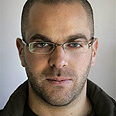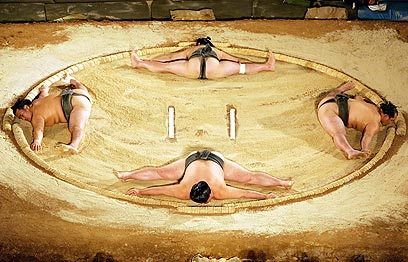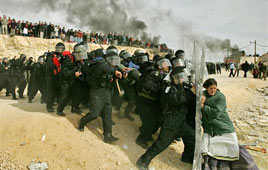
2 sides of the photo
'That’s the beauty of the photo: both sides think they’ve come up on top,' says Oded Balilty, Israeli photographer whose shot of Amona evacuation won 2007 Pulitzer Prize for photojournalism. 'Israel is a goldmine for press photographers,' he tells Ynet
Oded Balilty has made history: Not only is he the first Israeli photographer to win a Pulitzer, he was also nominated twice in the same category, meaning that he competed against himself.
Balilty competed in the “Breaking News” category as an Associated Press Israel team photographer for the coverage of the Second Lebanon War, and as an independent photographer.
Browsing through his work, it seems that Balilty has been blessed with the ability to stop time at the most dramatic moments, creating images rich with irony.
Balilty is no stranger to success as he has won no less than 10 international awards, including the World Press Photo prize for the Amona evacuation photo that got him the Pulitzer.
The series of photographs he took for AP in the Ukraine commemorating 20 years since the Chernobyl nuclear catastrophe won him four other competitions.

Family members of a IAF pilot course cadet, December 2005 (Photo: Oded Balilty)
In May he will be flying to New York to receive the most impressive award of all: The Pulitzer.
How do you explain your success?
“I am lucky, there are great photographers here. I assume it was a result of good decision making. I learned a lot from my colleagues.”
Who inspired you?
“I really admire James Kevin Frayer, Emilio Morenatti, and Enric Marti. Why them? They’re good editors and good people, which makes them good photographers. A good photographer is someone who quickly absorbs the surroundings, immediately reacting to all situations and recognizing a good shot half a second before it happens.”
Can these elements be taught?
“I don’t think so, yet they’re skills that can be developed. Being on the ground where the action is teaches you to react to the situation. I did not formally learn photography. Eli Hershkovich from Zoom77 taught me everything I know about professional photography, mainly to keep my cool, and how to conceptualize a frame."
How did you become a professional photographer?
“In high school I studied the arts and I knew that I wanted to take pictures, but it was only when I enlisted that I got to work as a photographer for BaMahaneh (the IDF Magazine). After the army I worked for Zoom77 and then for Yedioth Ahronoth. In 2002 I began working for AP. I work mostly in Israel and once a year I’m sent on assignment overseas.

Sumo wrestlers at the Caesarea Amphitheatre (Photo: Oded Balilty)
“I take lots of photographs of the Israeli-Palestinian conflict”, Balilty says. “It’s an integral part of life in Israel and sometimes the main part. Israel is a goldmine for press photographers. Big stories break all the time and they bring with them opportunities for powerful photographs. You quickly learn how to choose the best shots; during the disengagement I only shot five photos, but they’ll be here for a while”.
What was the most difficult situation you encountered in your professional life?
"It was at a funeral for a soldier killed in action. His girlfriend lay on his grave and cried, ‘I love you so much, why did you go?’ I broke down, and I’ve seen some terrible things in my life."
The award-winning photograph portrays despair. How do you think this photo of a determined girl who is facing many policemen will affect Israel’s image in the world?
“I see her as the strongest girl in the world. I couldn’t have done what she did because they would’ve broken my bones. She turned her disadvantage into an advantage.

Award-winning photo (Oded Balilty, AP)
"I wish I had the courage to do the things I believe in even when the odds are against me. I do a lot, but there still are things that I prevent myself from doing”.
Such as?
“I don’t work in Gaza. I photograph a lot less in the territories because I'm an Israeli.”
What kind of response do you get to the picture?
“Some say it reflects left-wing views, some say it's biased towards the right. That’s the beauty of the shot: both sides think they come up on top. One side says, ‘Look, she’s fighting them,' the other side says, ’Good, they’re evacuating settlers.'”
Isn’t that an expression of a schism?
“It isn’t my job to give interpretations; I prefer a shot that can be looked at in different ways.”
What are the responses overseas?
“Similar to the ones I received here. Someone phoned me and said the photo is very biblical: the gate, the landscape, and the stones. I truly think there is a biblical element to the shot, mostly due to the combination of spirit and matter; the smoke in the background, the people and the land, the girl’s clothing and the police in black”.
And the crowd in the background watching the fight?
"Yeah. The same person said that it reminds him of David and Goliath, only here David loses."










